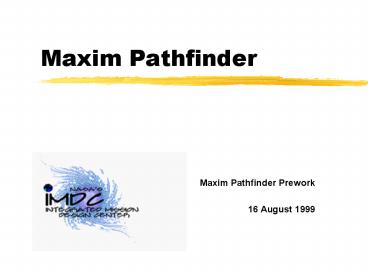Maxim Pathfinder - PowerPoint PPT Presentation
Title:
Maxim Pathfinder
Description:
Maxim Pathfinder is an X-ray telescope, preparing for a larger X-ray telescope ... Chandra and Constellation-X are precursors to Maxim ... – PowerPoint PPT presentation
Number of Views:89
Avg rating:3.0/5.0
Title: Maxim Pathfinder
1
Maxim Pathfinder
- Maxim Pathfinder Prework
- 16 August 1999
2
Maxim Pathfinder Prework Topics
- General
- Orbit and Pointing
- Data Acquisition Concepts
- Operations Concepts
- Suggestions for Study
- Work Style this Week
3
General
- Maxim Pathfinder is an X-ray telescope, preparing
for a larger X-ray telescope - the real Maxim - Chandra and Constellation-X are precursors to
Maxim - NGST, LISA and SIM are missions, active or
proposed, which will employ technology applicable
to Maxim ns/index.htm - Possible new start mission in 8 to 12 years
- Primary payload on one or two launch rockets
(probably 1) - 3-year lifetime
- Very good (incredibly good?) pointing stability
- Formation flying required to keep optics
spacecraft and detector spacecraft properly
aligned - See PathDesign2.doc (distributed Friday) for more
info
4
Orbit and Pointing
- Orbit parameters required
- Orbit which permits formation-flying two
satellites 450km apart, looking perpendicular to
the sun-satellite line - Only very small disturbance parameters allowable
during observations lasting up to 7 days
1. Assume the plane of this sheet is
perpendicular to the sun line. 2. Maxim can look
in any direction in the plane of this sheet 3.
Maxim can look out of the plane of this sheet by
only 10 4. Any celestial target can be viewed
within a period of 6 months
5
Data Acquisition Concepts
- Observations may last several days, but data
probably should be downlinked at intervals as the
observation progresses - Instrumentation on optics spacecraft will produce
10kbps spacecraft engineering data - Instrumentation on detector spacecraft will
produce 10kbps spacecraft engineering data - Recommend whether each spacecraft should downlink
separately, or one should relay data from both
satellites
6
Operations Concepts
- Early orbit operations will require adjustment of
the 64 flat mirrors. This implies either an
onboard automated process or real-time ground
interaction. - Target acquisition also may be either automated
onboard or accomplished with real-time ground
interaction (potential trade study). - Rapid slew from target to target is not required.
7
Suggestions for Study
- Recommend the type of orbit or trajectory best
suited to this mission. - Compare the pros and cons of having independent
data links from each satellite to ground vs.
having one satellite collect all the data for
both and relay that to the ground. - Does each satellite have independent data storage
or does that function get combined in one or the
other of the satellites. - Determine the best means of pointing the
satellites and maintaining pointing during
observations. - Determine whether data should be stored and
dumped at intervals or maintain continuous
contact, and whether ground antennas should be
shared with other missions or dedicated to this
mission. - Perform analysis of the thermal problems,
recommend and size radiators and other cooling
devices.
8
More Suggestions for Study
- Recommend placement of spacecraft subsystems on
both satellites, determining mass and momentum
properties. - Recommend a power subsystem for each satellite.
- Consider radiation precautions needed and
recommend necessary protection. - Recommend propulsion needed to achieve the
mission orbit (once we determine what it should
be) and recommend propulsion which may be needed
if pointing and stabilization cannot be
accomplished with wheels or other means. - Analyze potential effects of solar wind and how
that may affect pointing control of the
satellites. - Identify technology developments needed to enable
accomplishing the mission. Identify the expected
technology developments benefiting this mission
starting 10 years in the future.
9
Work Style this Week
- Emphasize a collaborative approach
- Many of the parameters the DET needs (mass, size,
power) will require a negotiated agreement
between affected parties - Maxim team and DET personnel need frequent
interaction - Scorecard of agreed parameters for reference by
all - Morning meeting each day at 930 to synchronize
everybody for the day - Informal splinter meetings of affected parties































